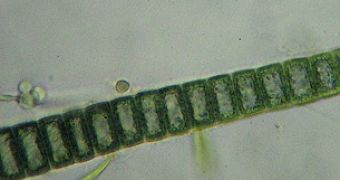The blue-green algae, scientifically called cyanobacteria, is one of the oldest living forms in nature, responsible for generating oxygen in the air we breathe. Researchers Hyun Woo Kim and Raveender Vannela, from the Biodesign Institute at Arizona State University, are searching for ways to grow these microbes in large quantities. This is also an opportunity for optimizing the photobioreactor(PBR), a device in which these photosynthetic organisms proliferate.
Several methods to produce clean forms of energy and replace fossil fuels were tested, still cyanobacteria turns out to be the most attractive. Hyun Woo Kim explains that the bacteria are much easier to re-engineer because scientists have a lot of information about them. Their growth can be controlled so that a large production of biofuel and biomaterial can be sustained.
In order to optimize the cyanobacterial growth, adding controlled amounts of CO2, phosphorus and sufficient light irradiation within the PBR vessel containing the microbial crop, is necessary. Researchers are studying the factors limiting production of cyanobacteria within the PBRs, to determine if a future large scale biofuel production is possible.
Compared with other biofuel sources, photosynthetic cyanobacteria can produce 100 times the quantity of clean fuel per acre, mainly because their survival needs are simple - sunlight, water, CO2 and a few nutrients. They do not need to be grown on arable land, taken from food production. Actually, cyanobacteria grows very well in rooftop PBRs or in any place where sufficient quantities of sunlight and CO2 can be provided.
Vannela says that “the PBR uses solar photons as an energy source to convert CO2 to reduced forms such as biomass, proteins, lipids and carbohydrates. It's a biological reactor, fixing solar energy into very useful forms of energy for human society.”. Cyanobacteria reproduce relatively fast and they are also tolerant of a large range of temperatures, salinities and pH conditions. These microbes can produce many chemicallly based materials, very useful for industrial applications, such as biopolymers and isoprenes.

 14 DAY TRIAL //
14 DAY TRIAL //